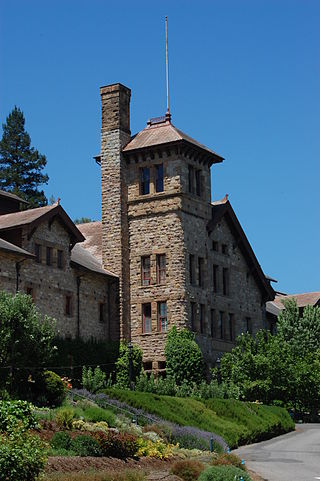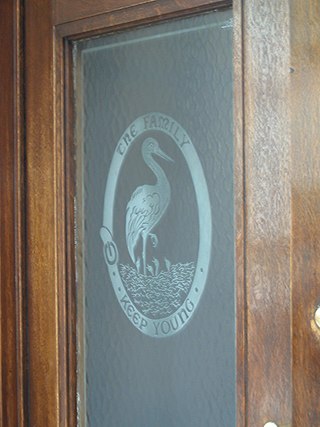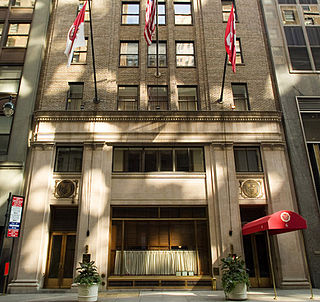
The Bohemian Club is a private club with two locations: a city clubhouse in the Nob Hill district of San Francisco, California, and the Bohemian Grove, a retreat north of the city in Sonoma County. Founded in 1872 from a regular meeting of journalists, artists, and musicians, it soon began to accept businessmen and entrepreneurs as permanent members, as well as offering temporary membership to university presidents and military commanders who were serving in the San Francisco Bay Area. Today, the club has a membership of many local and global leaders, ranging from artists and musicians to businessmen. Membership is restricted to men only.

The Commonwealth Club of California is a non-profit, non-partisan educational organization based in Northern California. Founded in 1903, it is the oldest and largest public affairs forum in the United States. Membership is open to everyone.

The Culinary Institute of America at Greystone is a branch campus of the private culinary college the Culinary Institute of America. The Greystone campus, located on State Route 29/128 in St. Helena, California, offers associate degrees and two certificate programs in culinary arts and baking and pastry arts. The CIA at Greystone and the Culinary Institute of America at Copia make up the school's California branch.

The Olympic Club is an athletic club and private social club in San Francisco, California.

Willis Jefferson Polk was an American architect, best known for his work in San Francisco, California. For ten years, he was the West Coast representative of D.H. Burnham & Company. In 1915, Polk oversaw the architectural committee for the Panama–Pacific International Exposition (PPIE).

The Palace Hotel is a landmark historic hotel in San Francisco, California, located at the southwest corner of Market and New Montgomery streets. The hotel is also referred to as the New Palace Hotel to distinguish it from the original 1875 Palace Hotel, which had been demolished after being gutted by the fire caused by the 1906 San Francisco earthquake.

The Pacific-Union Club is a social club located at 1000 California Street in San Francisco, California, at the top of Nob Hill. It is considered to be the most elite club of the West Coast, and one of the most elite clubs in the United States, along with the Knickerbocker Club in New York, the Metropolitan Club in Washington D.C., and the Somerset Club in Boston.

The California Club is an invitation-only private club established in 1888, based in Los Angeles, California.

The Harvard Club of New York City, commonly called The Harvard Club, is a private social club located in Midtown Manhattan, New York City. Its membership is limited to alumni, faculty and board members of Harvard University.

William Bowers Bourn II was an American entrepreneur and socialite. Bourn ran and controlled the Empire Mine and the San Francisco Gas Company, he was an investor in Spring Valley Water Company, and he led a merger to what later became Pacific Gas and Electric Company. Bourn II was the builder of many estates in California, including Filoli, the country estate in San Mateo County, California.

The James C. Flood Mansion is a historic mansion at 1000 California Street, atop Nob Hill in San Francisco, California, USA. Now home of the Pacific-Union Club, it was built in 1886 as the townhouse for James C. Flood, a 19th-century silver baron. It was the first brownstone building west of the Mississippi River, and the only mansion on Nob Hill to structurally survive the 1906 San Francisco earthquake and fire. It was declared a National Historic Landmark in 1966.

The Family is a private club in San Francisco, California, formed in 1902 by newspapermen who in protest, left the Bohemian Club due to censorship. The club maintains a clubhouse in San Francisco, as well as rural property 35 miles to the south in Woodside. The Family is an exclusive, invitation-only, all-male club where the new members are "Babies", regular members are "Children" and the club president is the "Father".

The Cornell Club of New York, usually referred to as The Cornell Club, is a private club in Midtown Manhattan, New York City. Its membership is restricted to alumni and faculty of Cornell University, family of Cornellians, business associates of Members, and graduates of The Club's affiliate schools.

The Stanford University Libraries (SUL), formerly known as "Stanford University Libraries and Academic Information Resources" ("SULAIR"), is the library system of Stanford University in California. It encompasses more than 24 libraries in all. Several academic departments and some residences also have their own libraries.

The Occidental Hotel opened in 1861 in San Francisco, California. It was destroyed in the San Francisco earthquake and subsequent fire of 1906. It was one of the many hotels named Occidental in the United States, and it was among the few luxury hotels in San Francisco that catered to wealthy travelers. Operating in the years that roughly coincided with the end of the California Gold Rush and the beginning of silver mining in Nevada, the Occidental Hotel was among the new, grand hotels in San Francisco. In the exclusive hotel market, along with the Occidental were the Lick House, the Russ House, the Cosmopolitan, the Grand, the Palace, and the Baldwin.
Walter Danforth Bliss (1874-1956) was an American architect from California. Many of his buildings are listed on the National Register of Historic Places.

Nob Hill is a neighborhood of San Francisco, California, United States that is known for its numerous luxury hotels and historic mansions. Nob Hill has historically served as a center of San Francisco's upper class. Nob Hill is among the highest-income neighborhoods in the United States, as well as one of the most desirable and expensive real estate markets in the country. Prior to Covid-19, it was the most expensive real estate market per metre squared, narrowly beating Monte Carlo, although it has since fallen heavily. It was the only place in the United States so far where market price per square metre exceeded the average yearly salary in the country.
The Francisca Club is a women's only private social club in San Francisco, California. It is apparently the oldest private women's club surviving in San Francisco and has been in its clubhouse since the 1920s. It had typically had a membership of around 500; however, recently this has declined to closer to 400.

The Lower Nob Hill Apartment Hotel District is a historic district located in the Nob Hill neighborhood of San Francisco, California, U.S.. It covers roughly a 5-block length in downtown San Francisco on the south slope of Nob Hill. It is sometimes referred to as the "Tendernob," the name is a portmanteau for the area that is the meeting point of the Tenderloin and Nob Hill. The Lower Nob Hill Apartment Hotel District is listed as a California Historical Landmark since July 31, 1991; and listed on the National Register of Historic Places since July 31, 1991, for architecture and social history.


















